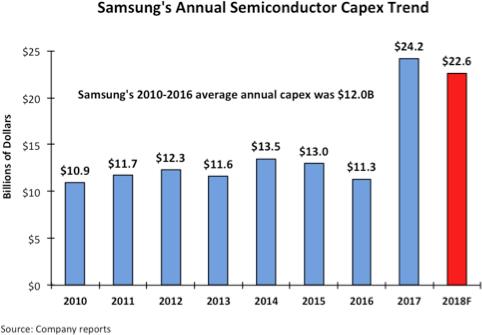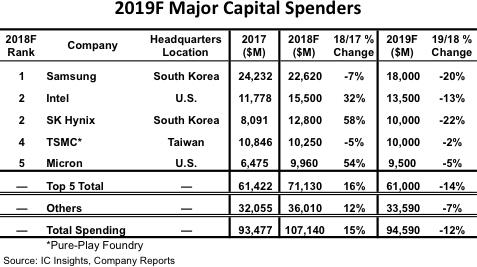After spending $24.2 billion for semiconductor capex in 2017, IC Insights forecasts that Samsung’s spending will edge slightly downward, but remain at a very strong level of $22.6bn in 2018 (Figure 1). If it comes in at this amount, Samsung’s two-year semiconductor capital spending will be $46.8bn.
As seen in Figure 1 (below), Samsung’s semiconductor capital outlays from 2010, the first year the company spent more than $10bn in semiconductor capex, through 2016 averaged $12.0bn per year. However, after spending $11.3 billion in 2016, the company more than doubled its 2017 capex budget. "The fact that Samsung’s continued its strong capex spending in 2018 is just as impressive," says IC Insights.

The research company believes that Samsung’s massive spending outlays in 2017 and 2018 will have repercussions far into the future. One effect that has already begun is a period of overcapacity in the 3D NAND flash market. This overcapacity situation is due not only to Samsung’s huge spending for 3D NAND flash, but also from spending by competitors (e.g., SK Hynix, Micron, Toshiba, Intel, etc.) that attempt to keep pace in this market segment.
With the DRAM and NAND flash memory markets showing strong growth through the first three quarters of 2018, SK Hynix ramped up its capital spending this year. In 1Q18, SK Hynix said that it intended to increase its capex spending by “at least 30%” this year.
IC Insights forecasts that SK Hynix will see a 58% surge in its semi capex spending. The increased spending by SK Hynix this year is focused primarily on bringing new capacity online at two of its large memory fabs—M15, a 3D NAND flash fab in Cheongju, South Korea, and the expansion of its huge DRAM fab in Wuxi, China. The Cheongju fab is being pushed to open before the end of this year. The Wuxi fab is also targeted to open by the end of this year, a few months earlier than its original start date of early 2019.
Overall, IC Insights’ now forecasts total semiconductor industry capital spending will climb 15% to $107.1bn this year, the first time that annual industry capex is expected to top $100.0bn. Following the industry-wide growth this year, semiconductor capex is expected to decline 12% in 2019 (Figure 2 below).
Given that the current softness in the memory market is expected to extend into at least the first half of next year, the combined capital spending by the three largest memory suppliers—Samsung, SK Hynix, and Micron—is forecast to drop from $45.4bn in 2018 to $37.5bn in 2019, a decline of 17%, adds IC Insights.

In total, the top five spenders, which are expected to represent 66% of total outlays this year, are forecast to cut their capital spending by 14% in 2019 with the remaining semiconductor industry companies registering a 7% decline, the research company concludes.













